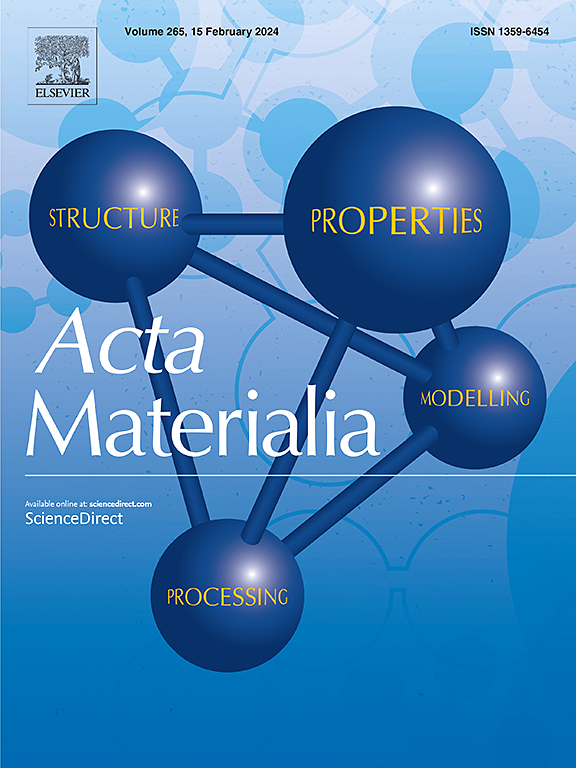TEM analysis of permanent lattice defects created by forward and reverse martensitic transformations proceeding under stress in nanocrystalline NiTi wire
IF 9.3
1区 材料科学
Q1 MATERIALS SCIENCE, MULTIDISCIPLINARY
引用次数: 0
Abstract
The origin of cyclic instability of stress-strain-temperature responses of NiTi shape memory alloy (SMA) in cyclic thermomechanical loads (functional fatigue) represents one of the unsolved problems in the SMA field. In particular, the mechanism by which incremental plastic strains and permanent lattice defects are generated during thermomechanical cycling is not known. To reveal it, we evaluated recoverable strain, plastic strain and permanent lattice defects in austenite created by forward and reverse martensitic transformations (MT) proceeding under wide range of external tensile stress by closed loop thermal cycling under constant stress and transmission electron microscopy (TEM) analysis of permanent lattice defects in austenite consisting of slip dislocations and deformation bands, variation of crystal lattice orientation and elastic strain field in grains.
We propose that forward MT proceeding upon cooling under external stress generates plastic strain via slip of [100](001) dislocations that nucleate at habit plane interfaces, glide in martensite across entire grains and disappear within grain boundaries. Reverse MT upon heating under external stress generates plastic strain also via [100](001) dislocation slip but on multiple slip systems within interfacial microstructure layers created by reorientation of martensite that propagate prior habit plane interfaces transforming the oriented martensite into plastically deformed austenite. Both forward and reverse MT proceed via cooperative transformation/twinning/slipping within large number of grains enabling shape strains in grains to remain compatible at grain boundaries.
When NiTi wire is subjected to cyclic thermomechanical loading, incremental plastic strains and permanent lattice defects are generated by the proposed deformation mechanisms anytime the forward and reverse MTs occur under external stress above certain thresholds characteristic for each NiTi wire. The plastic strains and permanent lattice defects accumulate upon thermomechanical cycling which brings about functional fatigue. Assuming dislocation slip in martensite as the origin of functional fatigue, it is discussed how NiTi-based alloys can be strengthened against it.


纳米晶NiTi丝在应力作用下正反马氏体相变产生的永久晶格缺陷的透射电镜分析
NiTi形状记忆合金(SMA)在循环热机械载荷(功能疲劳)下应力-应变-温度响应的循环失稳成因是SMA领域尚未解决的问题之一。特别是,在热机械循环过程中产生增量塑性应变和永久晶格缺陷的机制尚不清楚。为了揭示这一点,通过恒定应力下的闭环热循环和由滑移位错和变形带组成的奥氏体永久晶格缺陷的透射电子显微镜(TEM)分析,评估了在大范围外拉应力下进行的马氏体正相变和反向相变(MT)产生的奥氏体可恢复应变、塑性应变和永久晶格缺陷。晶粒中晶格取向和弹性应变场的变化。有人提出,在外部应力下冷却后进行的前向MT通过[100](001)位错的滑移产生塑性应变,这些位错在习惯面界面处成核,在整个晶粒中以马氏体滑动,并在晶界内消失。在外部应力下加热后的反向MT也通过[100](001)位错滑移产生塑性应变,但在由马氏体重定向产生的界面微观结构层内的多个滑移系统中,马氏体传播先前的习惯面界面,将定向马氏体转变为塑性变形的奥氏体。正向和反向MT都是通过大量晶粒内的合作转变/孪生/滑移进行的,从而使晶粒中的形状应变在晶界处保持相容。当NiTi丝受到循环热机械加载时,在超过特定阈值的外部应力作用下,每当正向和反向MTs发生时,上述变形机制都会产生增量塑性应变和永久性晶格缺陷。塑性应变和永久晶格缺陷在热-机械循环过程中积累,导致功能疲劳。假设马氏体的位错滑移是功能疲劳的根源,讨论了如何增强镍钛基合金的功能疲劳。
本文章由计算机程序翻译,如有差异,请以英文原文为准。
求助全文
约1分钟内获得全文
求助全文
来源期刊

Acta Materialia
工程技术-材料科学:综合
CiteScore
16.10
自引率
8.50%
发文量
801
审稿时长
53 days
期刊介绍:
Acta Materialia serves as a platform for publishing full-length, original papers and commissioned overviews that contribute to a profound understanding of the correlation between the processing, structure, and properties of inorganic materials. The journal seeks papers with high impact potential or those that significantly propel the field forward. The scope includes the atomic and molecular arrangements, chemical and electronic structures, and microstructure of materials, focusing on their mechanical or functional behavior across all length scales, including nanostructures.
 求助内容:
求助内容: 应助结果提醒方式:
应助结果提醒方式:


